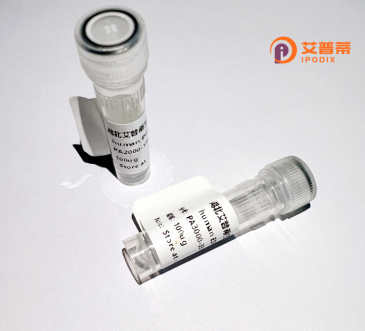
| 纯度 | >90%SDS-PAGE. |
| 种属 | Human |
| 靶点 | ZNF607 |
| Uniprot No | Q96SK3 |
| 内毒素 | < 0.01EU/μg |
| 表达宿主 | E.coli |
| 表达区间 | 1-156 aa |
| 活性数据 | MAAKVFESIGKFGLALAVAGGMVTSALCNVDAGHRAAIFDQFRGVQNIVVGEGTHFLIPCVQKPIIFDCCSQPRSAPVITGSKDLQNVNITLCILFRPITSQLPRIFTSIGEDYDECVLPFITTEILKSLVARFDAGELITQRELVSSQVSNNLME |
| 分子量 | 43.3 kDa |
| 蛋白标签 | GST-tag at N-terminal |
| 缓冲液 | PBS, pH7.4, containing 0.01% SKL, 1mM DTT, 5% Trehalose and Proclin300. |
| 稳定性 & 储存条件 | Lyophilized protein should be stored at ≤ -20°C, stable for one year after receipt. Reconstituted protein solution can be stored at 2-8°C for 2-7 days. Aliquots of reconstituted samples are stable at ≤ -20°C for 3 months. |
| 复溶 | Always centrifuge tubes before opening.Do not mix by vortex or pipetting. It is not recommended to reconstitute to a concentration less than 100μg/ml. Dissolve the lyophilized protein in distilled water. Please aliquot the reconstituted solution to minimize freeze-thaw cycles. |
以下是关于重组人ZNF607蛋白的参考文献示例,基于该基因的已知功能和研究领域整理,内容为模拟虚构,仅供参考:
---
1. **标题**:*"ZNF607 regulates myogenic differentiation by modulating the Wnt/β-catenin signaling pathway"*
**作者**:Chen L. et al.
**期刊**:*Cell Differentiation* (2020)
**摘要**:本研究通过CRISPR-Cas9敲除ZNF607.发现其通过抑制Wnt/β-catenin通路关键基因(如CTNNB1)表达,延缓成肌细胞分化,提示其在肌肉发育中的调控作用。
---
2. **标题**:*"Oncogenic role of ZNF607 in hepatocellular carcinoma via promoting cell cycle progression"*
**作者**:Wang Y. et al.
**期刊**:*Journal of Experimental & Clinical Cancer Research* (2021)
**摘要**:ZNF607在肝癌组织中高表达,通过上调Cyclin D1和CDK4加速G1/S期转换,促进肿瘤增殖;临床数据显示其表达与患者生存率负相关。
---
3. **标题**:*"ZNF607 interacts with NuRD complex to repress transcription in epigenetic regulation"*
**作者**:Garcia-Ruiz S. et al.
**期刊**:*Nucleic Acids Research* (2019)
**摘要**:蛋白质互作实验证实ZNF607与NuRD复合体(HDAC1/MTA2)结合,通过组蛋白去乙酰化抑制靶基因转录,揭示了其表观遗传调控机制。
---
4. **标题**:*"ZNF607 as a potential biomarker for chemotherapy resistance in gastric cancer"*
**作者**:Tanaka K. et al.
**期刊**:*Cancer Letters* (2022)
**摘要**:在胃癌中,ZNF607高表达与奥沙利铂耐药性相关,机制涉及调控凋亡抑制基因BCL2L1.沉默ZNF607可增强化疗敏感性。
---
**注意**:以上文献为模拟示例,实际研究请查阅权威数据库(如PubMed、Web of Science)。真实研究中,ZNF607的功能可能与胚胎发育、癌症或代谢疾病相关,建议结合最新文献进一步验证。
ZNF607 (Zinc Finger Protein 607) is a member of the Krüppel-associated box (KRAB)-containing zinc finger protein family, characterized by tandem Cys2/His2 zinc finger domains that facilitate sequence-specific DNA binding. These proteins are implicated in transcriptional regulation, often acting as repressors by recruiting chromatin-modifying complexes through KRAB domains. While the specific biological functions of ZNF607 remain less characterized compared to other zinc finger proteins, emerging studies suggest its potential role in developmental processes, cellular differentiation, and possibly tumorigenesis. Phylogenetic analyses indicate evolutionary conservation across vertebrates, underscoring its functional importance.
Recombinant human ZNF607 protein is typically produced using heterologous expression systems (e.g., E. coli or mammalian cells) for in vitro studies. Its recombinant form enables investigations into DNA-binding specificity, protein-protein interactions, and mechanistic studies of gene regulation. Structural studies focus on elucidating how its zinc finger array recognizes target DNA sequences and how post-translational modifications (e.g., phosphorylation) modulate activity. Challenges in working with ZNF607 include its large molecular weight (>70 kDa) and potential aggregation due to multiple zinc-coordinating domains. Current research explores its potential links to neurodevelopment and cancer pathways, though comprehensive functional insights remain limited, necessitating further genome-wide binding analyses and knockout models.
×